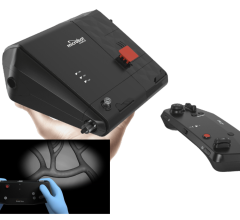
June 13, 2022 — Royal Philips announced the latest results from the Tack Optimized Balloon Angioplasty (TOBA) II below-the-knee (BTK) clinical trial, demonstrating that the Philips endovascular system – Tack (4F) – the first and only device of its kind approved by the U.S. Food and Drug Administration (FDA), provides a sustained treatment effect and positive impact on quality of life for patients with critical limb ischemia (CLI), a severe stage of peripheral arterial disease (PAD), out to three years of clinical follow-up.
CLI occurs when an obstruction in an artery severely reduces blood flow, causing painful wounds, debilitating rest pain, recurring ulcers and life-threatening infection. If left untreated, 50% of patients with CLI will undergo an amputation or die within the first year [1].
The TOBA II BTK trial studied the safety and efficacy of post-angioplasty dissection repair using the Philips Tack endovascular system in patients with CLI and infrapopliteal disease. The Tack endovascular system is a unique specialized implantable device to optimize the treatment of dissections in patients with CLI. Endpoints included rates of major adverse events, target lesion revascularization (TLR), target limb salvage (TLS) and quality of life (QoL) metrics.
“Based on 36-month follow-up in the TOBA II BTK trial, which is following 233 patients at 41 sites internationally, the Tack endovascular system offers a new standard in repairing below-the-knee arterial dissections,” said co-principal investigator George Adams, M.D., director of cardiovascular and peripheral vascular research at UNC Rex Hospital in Raleigh, N.C., and clinical associate professor of medicine at the University of North Carolina at Chapel Hill, who presented the results to hundreds of interventional cardiologists, interventional radiologists and vascular surgeons at the New Cardiovascular Horizons (NCVH) conference in New Orleans, USA, on June 2.
Adams added: “The device stands to significantly benefit patients with CLI whose treatment with balloon angioplasty often leads to this particular complication, which typically goes untreated and unaddressed, to the detriment of long-term clinical outcomes.”
The three-year analysis of TOBA II BTK results includes the following clinical insights on the Tack endovascular system:
- 93.9% target limb salvage in CLI patients at three years
- 69.6% freedom from clinically-driven target lesion revascularization across all patients at three years
- Sustained improvement in established clinical classification systems including the Rutherford clinical category and hemodynamics in ankle- and toe-brachial indices
- Sustained improvement in patient-reported quality-of-life and mobility measures
“In treating peripheral arterial disease below the knee with balloon angioplasty, dissections of the popliteal, tibial and peroneal arteries occur with considerable frequency,” explained Chris Landon, business leader of Image Guided Therapy Devices at Philips. “With the Tack endovascular system from Philips, interventionists can reliably repair below-the-knee arterial dissections – and in doing so, improve major amputation rates and quality of life.”
Philips has previously reported data from the TOBA II and III studies, which evaluated the Tack endovascular system for superficial femoral and proximal popliteal artery dissection repair following uncoated balloon angioplasty and/or drug-coated balloon (DCB) angioplasty. These multicenter, global and European studies demonstrated that the use of the Tack endovascular system resulted in overwhelming dissection resolution following uncoated or DCB angioplasty.
- In TOBA II, which involved uncoated and drug-coated balloons, dissection repair with the Tack System resulted in 89.6% and 86.5% 12-month primary patency (uncoated balloon group) and freedom from CD-TLR
- In TOBA III, which involved drug-coated balloons, dissection repair with the Tack endovascular system resulted in 95.0% and 97.5% 12-month primary patency and freedom from CD-TLR
There were no major adverse events reported through 30 days in either study.
Together, the TOBA II, TOBA III and TOBA II BTK trials support the safety and efficacy of the Tack endovascular system for post-PTA dissection repair in above- and below-the-knee arterial disease. The 36-month TOBA II BTK data reported at NCVH adds to the robust body of clinical evidence supporting the safety and effectiveness of the Tack Endovascular System in both vessel beds.
Philips Tack endovascular system is currently available for sale in the USA and some EU countries. Further information, including safety information, is available here. The system is part of the company’s peripheral vascular portfolio, which includes advanced interventional imaging systems for precision guidance including Vascular Suite on its Image Guided Therapy System – Azurion; intravascular ultrasound (IVUS) catheters to assess the location of the disease and lesion morphology and guide and confirm the treatment; peripheral atherectomy devices to remove blockages; sculpting balloons to prep the vessel; and peripheral therapy devices, such as Philips’ Stellarex drug-coated balloon, to treat lesions.
For more information: www.philips.com
Reference:
[1] Hirsh AT, Jaskal ZJ, Hertzer, et al. ACC/AHA 2005 guidelines for the management of patients with peripheral arterial disease (lower extremity, renal, mesenteric, and abdominal aortic): executive summary a collaborative report from the American Association for Vascular Surgery/Society for Vascular Surgery, Society for Cardiovascular Angiography and Interventions, Society for Vascular Medicine and Biology, Society of Interventional Radiology, and the ACC/AHA Task Force on Practice Guidelines (Writing Committee to Develop Guidelines for the Management of Patients With Peripheral Arterial Disease) endorsed by the American Association of Cardiovascular and Pulmonary Rehabilitation; National Heart, Lung, and Blood Institute; Society for Vascular Nursing; TransAtlantic Inter-Society Consensus; and Vascular Disease Foundation. J Am Coll Cardiol. 2006 Mar 21;113(11):e463-654.
Related Tack Device Content:
New Peripheral Stent Technology


 January 14, 2025
January 14, 2025 







